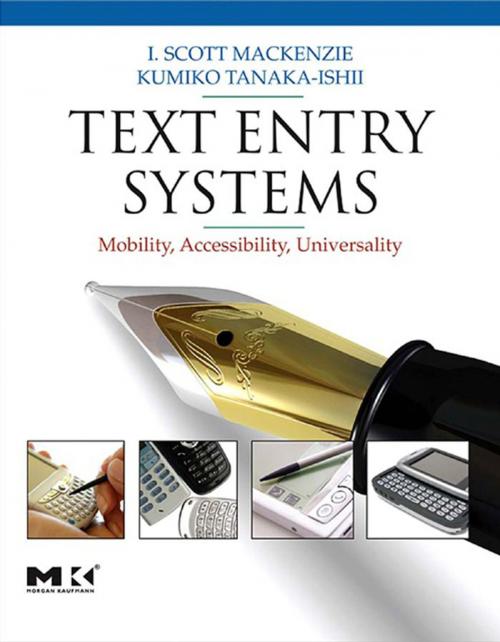Text Entry Systems
Mobility, Accessibility, Universality
Nonfiction, Computers, Advanced Computing, Natural Language Processing, General Computing| Author: | I. Scott MacKenzie, Kumiko Tanaka-Ishii | ISBN: | 9780080489797 |
| Publisher: | Elsevier Science | Publication: | July 28, 2010 |
| Imprint: | Morgan Kaufmann | Language: | English |
| Author: | I. Scott MacKenzie, Kumiko Tanaka-Ishii |
| ISBN: | 9780080489797 |
| Publisher: | Elsevier Science |
| Publication: | July 28, 2010 |
| Imprint: | Morgan Kaufmann |
| Language: | English |
Text Entry Systems covers different aspects of text entry systems and offers prospective researchers and developers global guidelines for conducting research on text entry, in terms of design strategy, evaluation methodology, and requirements; a discussion of the history and current state of the art of entry systems; and specific guidelines for designing entry systems for a specific target, depending on devices, modalities, language, and different physical conditions of users.
Text entry has never been so important as it is today. This is in large part due to the phenomenal, relatively recent success of mobile computing, text messaging on mobile phones, and the proliferation of small devices like the Blackberry and Palm Pilot. Compared with the recent past, when text entry was primarily through the standard "qwerty" keyboard, people today use a diverse array of devices with the number and variety of such devices ever increasing. The variety is not just in the devices, but also in the technologies used: entry modalities have become more varied and include speech recognition and synthesis, handwriting recognition, and even eye-tracking using image processing on web-cams. Statistical language modeling has advanced greatly in the past ten years and so therein is potential to facilitate and improve text entry — increasingly, the way people communicate.
- This book covers different aspects of text entry systems and offers prospective researchers and developers
- Global guidelines for conducting research on text entry, in terms of design strategy, evaluation methodology, and requirements
- History and current state of the art of entry systems, including coverage of recent research topics
- Specific guidelines for designing entry systems for a specific target, depending on devices, modalities, language, and different physical conditions of users
Text Entry Systems covers different aspects of text entry systems and offers prospective researchers and developers global guidelines for conducting research on text entry, in terms of design strategy, evaluation methodology, and requirements; a discussion of the history and current state of the art of entry systems; and specific guidelines for designing entry systems for a specific target, depending on devices, modalities, language, and different physical conditions of users.
Text entry has never been so important as it is today. This is in large part due to the phenomenal, relatively recent success of mobile computing, text messaging on mobile phones, and the proliferation of small devices like the Blackberry and Palm Pilot. Compared with the recent past, when text entry was primarily through the standard "qwerty" keyboard, people today use a diverse array of devices with the number and variety of such devices ever increasing. The variety is not just in the devices, but also in the technologies used: entry modalities have become more varied and include speech recognition and synthesis, handwriting recognition, and even eye-tracking using image processing on web-cams. Statistical language modeling has advanced greatly in the past ten years and so therein is potential to facilitate and improve text entry — increasingly, the way people communicate.
- This book covers different aspects of text entry systems and offers prospective researchers and developers
- Global guidelines for conducting research on text entry, in terms of design strategy, evaluation methodology, and requirements
- History and current state of the art of entry systems, including coverage of recent research topics
- Specific guidelines for designing entry systems for a specific target, depending on devices, modalities, language, and different physical conditions of users















